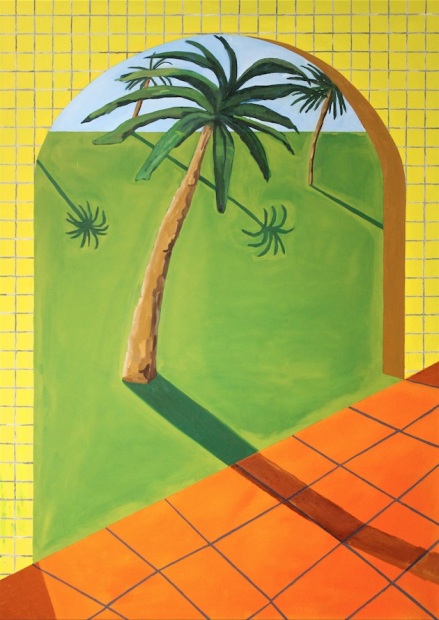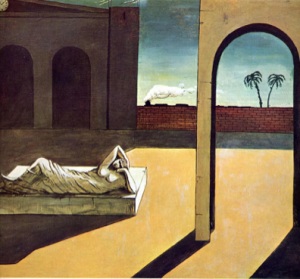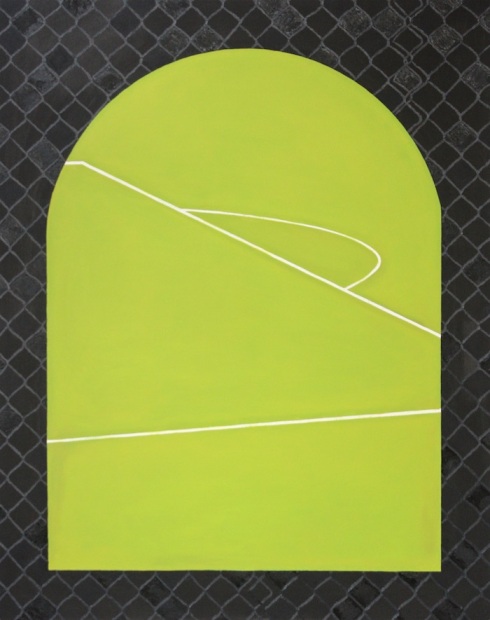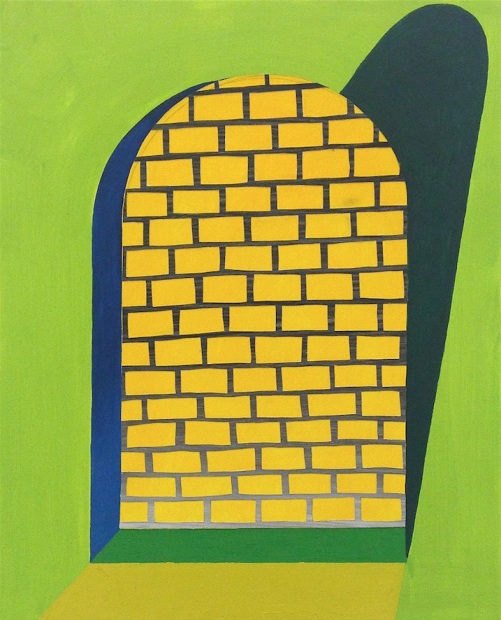Bradley Kerl’s paintings, currently on view at Art Palace in Houston, present nondescript, everyday settings filtered through the lens of some of painting’s heavy hitters: Giorgio de Chirico, Henri Matisse and Ellsworth Kelly. The title of the show, Blind Arcade, is a phrase that describes an architectural decorative element: an arched colonnade that appears to inhabit deep space and provide passageway but is, in fact, blocked off. Both implying and denying space, a blind arcade is an apt metaphor for illusionary painting.

Bradley Kerl, Out on the Coastal Plains (Four Palms)2014. Oil, collage on canvas, 84 x 60″

Giorgio de Chirico, The Soothsayer’s Recumbence, 1913
In each of Kerl’s paintings, arched doorways mark the transition between the viewers’ space, the surface of the canvas and the ambiguous place depicted. Kerl’s Out on the Coastal Plains (Four Palms) seems to enlarge a detail from de Chirico’s 1913 painting The Soothsayer’s Recumbence, in which an archway frames two palm trees behind a brick wall. Made a century later, Kerl’s version echoes de Chirico’s brick patterning in the tiled floor and arch, which frame similar trees. Still Life with Three Tennis Balls is a small painting of a woven basket, a potted plant and some tennis balls, in a nod to Matisse’s paintings from the years after the artist visited southern Spain and Morocco. Kerl balances the looseness with which he paints the plant’s leaves with a marvelous intensity of labor spent on rendering the basket’s multicolored weave in undulating strips. I see Ellsworth Kelly’s influence in the flat green leaves in Still Life with Three Tennis Balls and Theme Park and in the division of space into segments of blue, green, orange and yellow shapes in Empty Room. That Matisse and Kelly have recently had major retrospective exhibitions shows Kerl is up-to-date in his looking. Through these references, Kerl participates in the painter’s favorite game, establishing links to the history of painting and updating these artists’ themes with contemporary motifs. A soccer field, a fish tank, the aforementioned potted plants and palm trees: Kerl’s subjects speak to the anonymity of a doctor’s reception room, the suburban golf course and the non-aesthetics of contemporary life.

Bradley Kerl, Pitch 2014
Such banal subjects give Kerl an opportunity to focus on the technical aspects of his painting. The most interesting moments in Kerl’s show are in the details: the three shades of black that form the tiled archway in Pitch, for example. Too subtle to be seen in photographs, the black-on-black-on-black tonality is revealed by shifting light as one moves around the painting. In addition to the play of real light on the surface of the canvas, pay attention to the painted shadows, which shift the perspective of the image against expectation in Empty Room and Theme Park.

Bradley Kerl, Blind Arcade, 2014
In the painting that gives the show its title, the Blind Arcade is a literal one: an arched passageway whose depth—a centimeter-deep reality which nonetheless gives the surface the hint of shadow as well as texture—suggests the possibility of passage into a closed off space.
Full of painterly witticisms, in his first show Kerl demonstrates the hallmarks of good painting: an acknowledgement of its history and a formal playfulness with its color, space, perspective, surface and texture.



1 comment
Risa Puleo takes us on an insightful romp through the genesis of Bradley Kerl’s Blind Arcade. For the self-taught artist this is an introduction into at first glance appears to be a side street of art that in reality … is a major highway of artistic thought. Kudos.